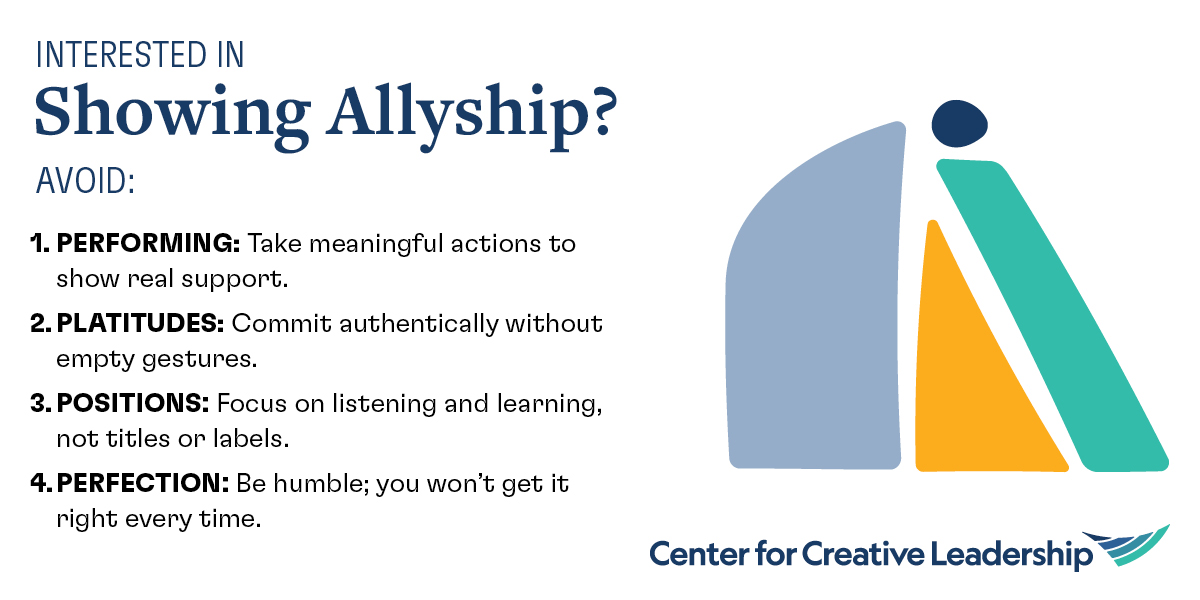The Meaning of Allyship & How Leaders Can Show It
In our work to advance equity, diversity, and inclusion within organizations and communities, we’ve found many leaders asking us, “How can I serve as an ally for others?” And more fundamentally, “What is allyship?”
In our webinar on Becoming an Ally in Times of Racial Unrest, we shared some our thinking on the meaning of allyship and the role that leadership plays when working through issues of inequity within our organizations and communities.
During that session, participants submitted questions they had on the topic, and since then, we’ve reflected on more thoughts on showing allyship, so we offer the following recommendations, which we hope are helpful. In sharing our approach to these responses, we also hold space as 2 facilitators with different racial identities — Joanne identifies as South Asian; Jayke is White.
First, What Is Allyship?
When we talk about the meaning of allyship in the workplace, we’re referring to the actions, behaviors, and practices that leaders take to support, amplify, and advocate with others, most especially with individuals who don’t belong to the same social identities as themselves. (Note that we say “advocate with …” rather than “advocate for …” because advocacy should be done in partnership with those we intend to serve.)
At CCL, our approach to this work has been less about answering the question “What is allyship?” and more about reframing that question into “How can we act as allies?”
Fundamentally, when we’re working on allyship, we’re talking about ally as a verb, and not a noun: we’re talking about actions and behaviors that make an impact, rather than a label or a title that gives someone moral credibility or social capital.
As a side note, some leaders who identify as BIPOC (Black, Indigenous, or Persons of Color) have been calling for an adoption of new language to describe the role of an “ally,” in terms such as “co-conspirators” or “accomplices.” And in some cases, leaders of racial equity work have stopped using the term “allyship” altogether, to prioritize language beyond positional titles that better reflects the actions, behaviors, and practices that leaders are being increasingly called on to play in society.
But we choose to use the terms “ally” and “allyship” for now as a more familiar point-of-entry to conversations about race and other issues of inequity, with an awareness and acknowledgement that allyship is an imperfect term.
How Can I Become a Better Ally?
What Leaders Must Do to Show Allyship
First, it’s important to note that allyship isn’t a single action, rather it’s ongoing action itself, with a focus on other people, not on yourself. That being said:
- Allyship needs to start with an examination of self, to better understand the power, privilege, and access available to you as an individual, as a result of the different identity groups to which you belong. Once you understand social identity and you’re more fully aware of the power and access that you have available to you in relation to the groups you aspire to serve, you’ll be in a much better position to leverage those privileges to advocate with and for others.
- Being an ally also requires deep education about the communities that you’re interested in demonstrating allyship toward. We always recommend the approach of educating ourselves through the avenues available first, before reaching out or leaning on others to teach us. Educational sources are readily available through a multitude of platforms (e.g., local libraries, on the Internet via advocacy websites and media accounts, and local and national organizations, among others).
Building a strong foundation of competencies, knowledge, and awareness is the best way to turn allyship from a buzzword into actual, sustainable behaviors that create inclusive environments and build a sense of belonging at work.
An example is the decision-making and selection process for teams within organizations. Often, when senior leaders pull together a task force to deal with a challenge, they lean on those who they know best and may unintentionally overlook others. As an ally at work, you can show inclusive leadership and advocate with and for someone who doesn’t get tapped on the shoulder to join the team to ensure that other leaders are aware of that individual’s unique and valuable talents and perspectives.
A common misconception of allyship is that it requires big, public action or loud proclamations of beliefs and values. But loudly professing allegiance without taking any meaningful actions of support is merely performative allyship.
In contrast, true allyship is available in every interpersonal interaction and can be very powerful when demonstrated through quiet, private actions and being a compassionate leader.

What Happens if I Try to Be an Ally & I Get It Wrong?
This question comes up because people are worried about “doing allyship right.” But if we are treating allyship as an ongoing, constant set of practices, we are going to get something wrong, eventually. Mistakes are going to happen.
Regardless of where you are on your allyship journey, right now is the time to get used to the idea that showing allyship is an inherently uncomfortable thing to do. It takes courage, vulnerability, and humility — both to put ourselves out there, but also when we realize we’ve gotten it wrong.
Allyship mistakes happen by those who are even the most well-intended: We may intend to speak out for someone who we think is being treated unfairly, and then later learn they found it offensive that we didn’t let them speak for themselves. Or we may think we’re giving an affirming compliment to someone’s cultural identity, only to find that the impact was that they thought the comment was insulting.
Our intent and the impact we have on others are often different, but it doesn’t mean that we give up trying to do what’s right. Leaders learn from their mistakes, no matter how difficult the lesson. In the words of Maya Angelou, “Then when you know better, do better.”
While the impact we have as leaders and allies is ultimately what matters, the failure of leaders to even act on their positive intentions out of the fear of perfection is what we find most often holds them back from being strong allies.
Many leaders never “get it wrong” because they’ve never really tried to “get it right,” and have avoided difficult allyship practices such as engaging in difficult conversations and collaboration.
Failing to engage in allyship out of the fear of perfection has the same consequences as failing to engage out of apathy: conversations don’t happen, mindsets don’t shift, and systems don’t change. In fact, engaging in conversation and collaboration enables individuals to create connections, build psychological safety, and maintain healthy relationships.
When you do choose to engage, you’ll likely find yourself feeling “called out” by someone, eventually, for something you said or did. In these moments, it’s more important than ever to keep trying, choose not to give up, and avoid getting discouraged to the point of checking out. This hard work is part of the process, but often a necessary one for us to learn.
Whether you agree with the feedback or not, we recommend first recognizing the courage it took for someone to give you that feedback, and to use it as an opportunity for reflection and growth. Misunderstandings happen, and there may be opportunity to have a follow up conversation later. However, leaders set themselves up for failure when they react to being called out by getting defensive, dismissive, angry, or upset to the point that it becomes about managing your own response to the neglect of the feelings of the person who gave the feedback.
If you are truly well-intended with your actions, the feedback (regardless of whether you fully agree with all of it or not) is worth learning from to have a better impact the next time. Remember: Don’t give up!
Keep trying, because truly understanding what allyship means and how to show it at work is critical for good leaders, no matter their position in the organizational hierarchy, if they want to continue to become better leaders. (At CCL, we’re focused on how leadership can and should evolve with our changing world. We invite you to explore our many resources for (better) leadership.)
What’s the Best Way to Help Senior Leaders Understand the Importance of Allyship at Work?
Although the need for more diverse teams and equitable and inclusive environments has existed for as long as organizations have, recent years have showcased that organizations are not as close to having diverse, inclusive, and equitable environments as they might have believed.
Studies have repeatedly shown that diverse teams drive better business performance, and companies with more diversity become more innovative, resilient, and better able to respond to complex challenges. In addition to understanding the business case for having diverse perspectives, there’s also a strong likelihood that the benefits of a diverse and inclusive organizational environment are already reflected in your organization’s mission statement and values. Most often, we find that linking to the business case and moral imperatives helps to bring leaders on board.
Corporate diversity and inclusion statements must show real commitment to advancing on goals for equity, diversity, and inclusion. It’s important that allyship in the workplace isn’t just cosmetic platitudes or empty gestures.
At CCL, clients who partner with us to build equity, diversity, and inclusion utilize our REAL™ framework to help them understand the relevant opportunities that are available to them at their organization through elevating equity, activating diversity, and leading inclusively.
We typically find that this approach demonstrates the need and value of true allyship in the workplace by tying it to an organization’s unique culture and values. This is key for long-term workplace culture change and taking real, concrete actions in support of professed values and commitments.
How Does Allyship for Racial Equity Take Place in an Organization That’s Mostly Homogenous?
For leaders who operate in mostly homogeneous spaces, this is a common question and challenge that comes up. In the United States, homogeneity typically refers to predominantly White organizations, but extends to other identity groups who often make up the majority group of employees and tend to hold the most positional power within organizations, such as men, cisgender, able-bodied, and neurotypical individuals, people who are heterosexual, and people of the Christian faith.
We’re intentionally framing this response with White audience members in mind, who we argue are ultimately responsible for the practices of allyship, especially within predominantly White organizations.
There is no better space or opportunity for White employees to serve as an ally and advocate for racial equity than there is within a homogenous organization. Period.
For White people, allyship in the workplace isn’t just about supporting colleagues from historically marginalized, underestimated groups while they’re in the room. The meaning of allyship is more about the often-behind-the-scenes work helping all of our colleagues, specifically those in power, to better understand the systems in place that make equity, diversity, and inclusion necessary for our other colleagues … even when it’s difficult, or even when it feels risky.
Access Our Webinar!
Watch our webinar, Introspection Into Action: Becoming an Ally in a Time of Racial Unrest, and learn immediate actions you can take towards becoming a better leader and ally and creating an inclusive environment.
It’s about helping other White leaders understand why diversity and inclusion are important organizational values. It’s helping team members to understand why a diversity of perspectives and identities will add incredible value to your team. It’s about helping other White leaders to examine why the organization is homogeneous in the first place, and identifying relevant opportunities to change that.
We’re big believers in the “If not you, then who?” approach in this regard. Serving as an ally isn’t just about managing the interpersonal dimensions of diversity and inclusion, but about helping to prioritize equity, not just diversity and inclusion, across the systems, policies, and practices in which we operate — even (and especially) when it’s difficult. Every system, including homogeneous ones, will benefit from that form of allyship in the workplace.
Effective Allyship: Moving Beyond Awareness Into Action
In closing, to answer the question “What is allyship?” we must look beyond just the meaning or definition of allyship or mere awareness of the concept, and instead identify ways that we as individual leaders can move into action and advocate with and for others. And while shifting individual behaviors is key, lasting change requires teams and organizations to make shifts collectively.
Ready to Take the Next Step?
Help your organization move beyond awareness of allyship toward taking meaningful actions with our Beyond Bias™ solutions, designed to equip your team to recognize, address, and overcome unconscious bias and create a more inclusive organizational culture.
Frequently Asked Questions About Allyship
Through our programs, research, and decades of experience developing leaders around the world, we hear common questions relating to allyship at work. Below are several frequently asked questions, and our answers.
-
What does allyship mean?Allyship refers to the actions, behaviors, and practices that leaders take to support, amplify, and advocate with others, especially with individuals who don’t belong to the same social identity groups as themselves.
-
What is allyship in the workplace?Allyship isn’t a single action; rather it’s ongoing action itself, with a focus on other people, not on yourself. That being said, allyship needs to start with an examination of self, to better understand the power, privilege, and access available to you as an individual, as a result of the different identity groups to which you belong.
-
How do you become an ally?Building a strong foundation of competencies, knowledge, and awareness is the best way to turn allyship from a buzzword into actual, sustainable behaviors that create inclusive environments and diverse teams. Once you’re more fully aware of the power and access that you have available to you, in relation to the groups you aspire to serve, you’ll be in a much better position to leverage those privileges to advocate with others.
-
Why is allyship important?Serving as an ally isn’t just about managing the interpersonal dimensions of diversity and inclusion, but about helping to facilitate greater equity across the systems, policies, and practices in which we operate — even and especially when it’s difficult. Every system, including homogeneous ones, will benefit from that form of allyship.
More questions? Our experts are here to help. Let’s have a conversation!











